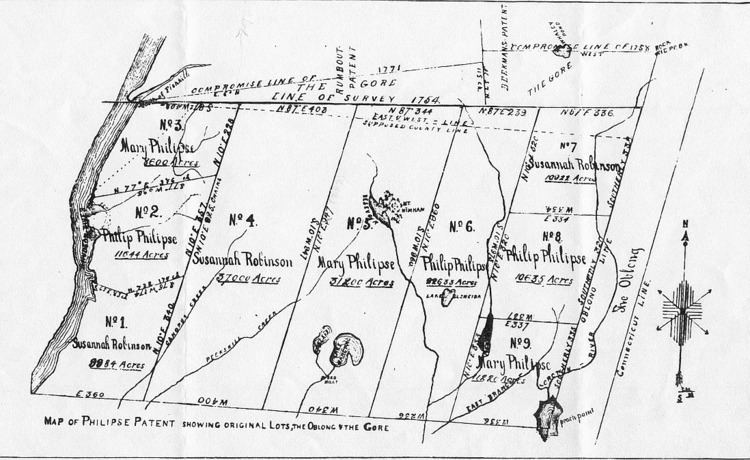 | ||
The Philipse Patent was a large tract of land purchased by Adolphus Philipse, a wealthy landowner of Dutch descent in the Province of New York, which became today's Putnam County.
Contents
Bought from two Dutch traders and Royally sanctioned as the Highland Patent in 1697, it encompassed some 250 square miles spanning from the Hudson River to the then Connecticut Colony along the northern Westchester County border. It was divided in 1754 among heirs but remained in the Philipse family until seized during the American Revolution. The Commissioners of Forfeitures auctioned it in parcels, without compensation to its prior owners.
Purchase
Adolphus was the second son of Frederick Philipse, the first Lord of the Manor of Philipsborough, a Dutch immigrant to North America of Bohemian heritage who had risen to become one of the greatest landholders in the New Netherlands.
In 1697 he Philipse purchased a tract of land from Dutch traders Lambert Dortlandt and Jan Sybrandt, who had bought it a few years before from several Wiccopee chiefs. This became known as the Highland Patent, and extended approximately 13 miles along the east shore of the Hudson River, from Annsville Creek to the Fish Kill, and eastward some 20 or so miles to the border of the Colony of Connecticut, including Pollopel Island in the Hudson.
Shortly after purchasing it, Philipse, whose residence was the Philipse Manor Hall near Tarrytown, and who maintained only a bachelor shooting lodge on Lake Mahopac in the Highland Patent, opened the tract to tenant settlers. Thus began a policy that lasted throughout his lifetime and his heirs' so long as they owned the land, to rent rather than sell, a practice which led to stunted growth for two and a half centuries to come.
Inheritance
Upon Frederick's death in 1702, Adolphus inherited a partial share of the Manor's lands, which then amounted to over 80 square miles and encompassed the bulk of today's lower Westchester County. The title and balance of the lands passed to his nephew, Frederick Philipse II, whose father Philip, elder brother of Adolphus, had predeceased Frederick I.
Division
Adolphus Philipse died in 1750 (Smith, 1749), with the Highland Patent passing to Frederick II, his only heir-at-law. Upon Frederick II's death in 1751, the Manor went to his son Frederick Philipse III, while the Patent was divided among four of Frederick II's offspring: son Philip Philipse, and daughters, Susannah (wife of Beverley Robinson), Mary (wife of Col. Roger Morris), and Margaret, who died intestate.
By terms of her father's will Margaret's portion was then equally divided among her brother and sisters. After a 1751 survey, the tract was geographically divided into nine Lots as seen in the preserved undated pen and ink map (bearing a survey date as late as 1771): three on the river, three in the interior, and three on the eastern border abutting the Oblong. Each of the three heirs inherited a lot in each division.
Seizure
Frederick was a Loyalist during the American Revolution. As such, he was attained by the Provincial Congress of New York in 1779 and his Manor and other lands in today's Westchester County were seized. Several months later their sale was ordered.
Philipse family holdings belonging to other members, principally the Highland Patent, were also seized by the Commissioners of Forfeitures. Sale was withheld during the war, as its outcome was uncertain, confiscated lands had been pledged as collateral against monies borrowed by the provisional government to finance the conflict, and tenants lobbied for the right of preemptive purchase of leased land.
Sale proceeded after the Revolution ended. In spite of assurances of restitution in the 1783 Treaty of Paris signed with the British, and the enormous sum raised – the better part of a quarter of a million pounds Sterling – New York's Provisional Congress reneged and no compensation was forthcoming.
Several thousand acres of the Philipse estate went to the tenant farmers who worked on the land. In all, the lands were divided up into almost 200 different parcels, with the bulk of the holdings going to Dutch New York businessman Henry Beekman.
In 1787, a British court decided that the inheritance rights of heirs to property that was confiscated by the Americans during the American Revolution was recoverable. Under this decision, John Jacob Astor I purchased the reversionary rights to the Philipse lands in 1809 from the heirs of Roger Morris (husband of Mary Philipse) for £20,000. After Mary Philipse Morris died in 1825, Astor attempted to collect rents on the lands, but the new “owners,” who had purchased from the lands from the NY Commission of Forfeiture, refused to pay, and Astor tried to evict them. A compromise was reached in 1828 when NY State compensated Astor for the reversionary rights in the amount of $500,000.
Incorporation
The Highland Patent had been incorporated into Dutchess County in 1737, where it was known as the "South Precinct." In 1806 a very small portion north of the Hudson Highlands by the mouth of Fishkill Creek was split off to from Philipstown (which had been established in 1788 out of the westernmost three and part of a fourth parcel of the Philipse Patent) and given to the Town of Fishkill. In 1812 the balance of the Philipse Patent was separated from Dutchess County and became today's Putnam County.
